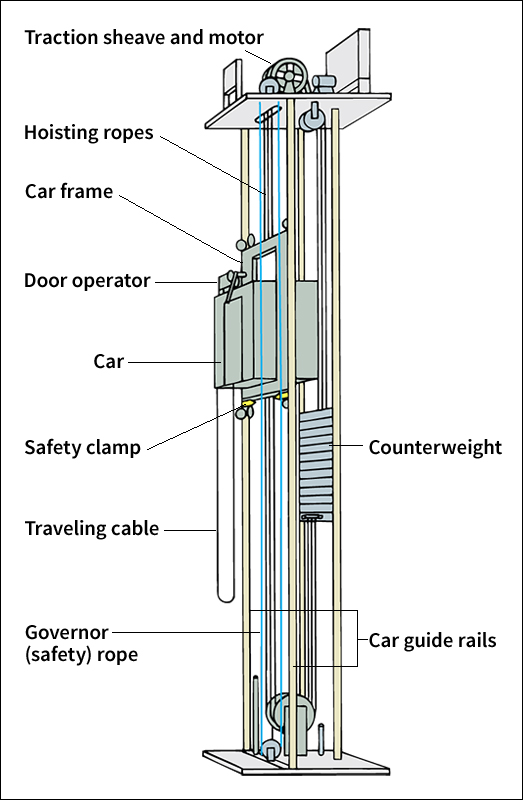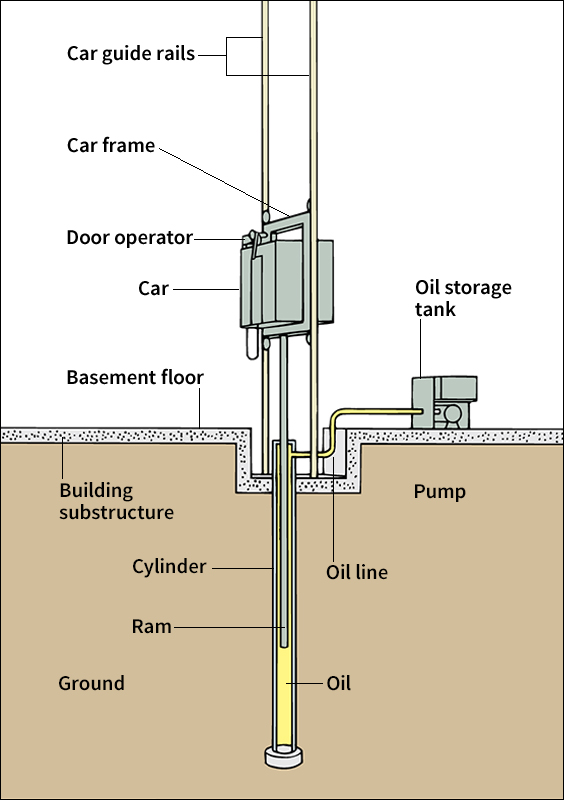Elevator is a device that carries people and freight up and down the floors of a building. The word elevator usually means the car in which the people or freight travel. But the term also refers to the entire system. The car travels up and down in a shaft. Steel guide rails in the shaft prevent movement sideways. In the United Kingdom and some other countries, an elevator is called a lift.
The development of elevators led to the construction of skyscrapers. Elevators enabled architects to design taller buildings because people no longer had to climb stairs to the upper floors.
The passenger elevators in office and residential buildings can carry from roughly 2,000 to 5,000 pounds (900 to 2,300 kilograms). Some freight elevators can carry as much as 100,000 pounds (45,000 kilograms).
How elevators work.
Most elevators operate automatically. Only a few are run by attendants who ride in the cars. A person brings an elevator to a certain floor by pushing a “call” button in the wall. The elevator doors open automatically after the car arrives at the floor. They close after the passenger has entered the elevator. The passenger pushes a button to indicate the floor where he or she wants the elevator to stop.
Most elevators in buildings of 10 or more floors are powered by electric traction systems. The cars are lifted by steel cables. There are two types of electric traction elevators, gearless traction and geared traction.
Loading the player...Direct-current motor
Gearless traction elevators are used in office buildings of more than 10 floors. They are also used in residential buildings of more than 30 floors. They travel at speeds of hundreds of feet or meters per minute. Cables called hoisting ropes lift the car. One end of each cable is attached to the top of the car. The other end is connected to a heavy steel counterweight. The counterweight balances the weight of the car and about half of its maximum passenger load. The counterweight reduces to a minimum the power needed to operate the elevator. The hoisting ropes fit around a sheave (pulley) that is connected directly to an electric motor. As the sheave turns, the ropes move and the car goes up or down. A brake holds the car in place when the elevator stops.
Geared traction elevators travel at speeds as high as 500 feet (150 meters) per minute. Geared traction elevators are similar to the gearless traction type of elevator. But the motor of a geared traction elevator operates a reduction gear, which turns the sheave. This gear decreases the speed at which the sheave turns.

Some elevators, called hydraulic elevators, are driven by a hydraulic system. They are moved by a long ram (piston) instead of by steel cables. Such elevators travel at speeds of 50 to 150 feet (15 to 46 meters) per minute. They serve mainly buildings of six or fewer stories. The ram rises and lifts the elevator when an electric pump forces oil into the ram cylinder. The elevator goes down when a valve opens and the oil flows into a storage tank.

Safety features.
National and international standards bodies have established safety codes under which elevators must operate. Local government officials inspect elevators regularly to make sure that all the safety features are functioning.
Passenger elevators must have steel doors that can withstand fire. Most have two sets of doors. One set is in the walls at each floor. The other set is part of the car itself. Both sets of doors must close and lock before the elevator can move. A special safety device causes the doors to reopen if someone is in the doorway. If an elevator goes down too fast, safety clamps grab the guide rails and stop the car. All automatic elevators have alarm bells and telephones. Passengers can use these instruments to call for help if the elevator stops between floors.
Special kinds of elevators.
A few large buildings have double-deck elevators. These elevators have two compartments and serve two floors with each stop. People who want odd-numbered floors enter the lower compartment on the first floor. People who want even-numbered floors enter on the second floor and ride in the upper compartment. Elevators called observation elevators have glass sides. They travel along the walls of interior courts or the outside walls of buildings. Passengers can view their surroundings through the glass.
Some tall buildings have express elevators that travel nonstop to certain floors called sky lobbies. In the sky lobby, passengers change to local elevators. The local elevators then carry the people to their floors.
Construction companies use special elevators called hoists that travel along the outside of buildings. These elevators carry crews and building materials, rather than the general public. Other kinds of elevators take workers and materials into mines. Hospital elevators are large enough to carry beds and stretchers.
History.
The ancient Greek mathematician Archimedes invented a type of elevator before 230 B.C. It used ropes and pulleys and could lift one person.
Elevators became common in the United States and England during the early 1800’s. By the 1840’s, both hydraulic and steam-powered freight elevators had been invented. But the hydraulic elevators were slow. The ropes of the steam-powered elevators often broke, and the cars fell.
In the early 1850’s, Elisha Graves Otis of Yonkers, New York, invented the first elevator that had an automatic safety device. If the rope broke, the device prevented the elevator from falling. Otis first demonstrated the elevator in 1854. The world’s first elevator designed for passenger use was installed in New York City in 1857. In 1880, the German inventor Ernst Werner von Siemens introduced the first electric elevator.
Automatic elevators were introduced in residential buildings in the 1890’s. Attendants operated the elevators in major office buildings until 1950. That year, an office building in Dallas became the first with automatic elevators.
See also Grain elevator; Otis, Elisha Graves; Siemens, Ernst Werner von.
